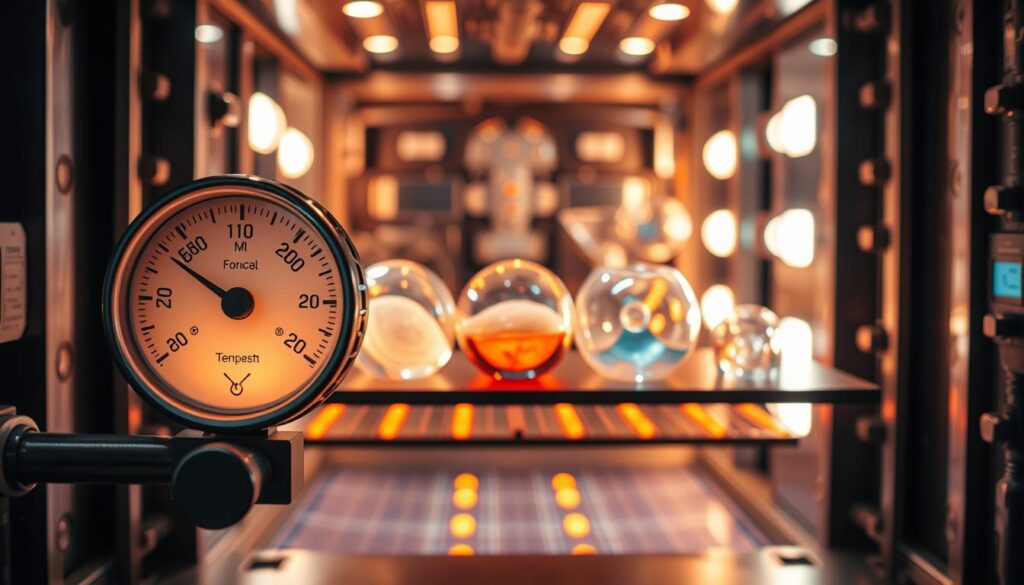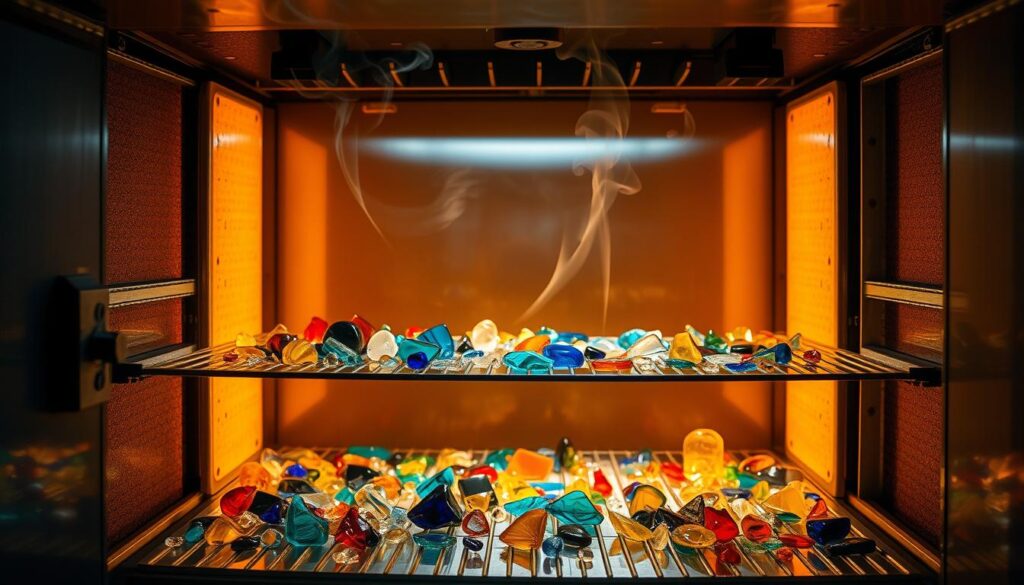When working with glass, knowing how it reacts to heat is crucial. The COE measures how much a material expands with temperature changes. This is especially important in glass fusing, where mismatched pieces can lead to cracks or breaks.
At Fuse Muse Fused Glass, we specialize in providing tools and education tailored to specific COE values. Whether you’re using Bullseye (90) or Oceanside (96), we ensure you have the right materials for your projects.
Proper annealing schedules are essential to prevent stress fractures in your work. By mastering COE, you can create durable, safe, and beautiful glass art. Stay tuned as we explore compatibility issues, temperature ranges, and more.
What is COE (Coefficient of Expansion) in Glasswork?
Glass expands and contracts with temperature changes, and understanding this behavior is key to successful projects. The coefficient of expansion measures how much a material grows or shrinks when heated or cooled. For glass, this is calculated between 20°C and 300°C, a critical range for fusing and annealing.
Definition and Basic Science Behind COE
Every type of glass has a unique expansion rate. For example, soda lime glass expands at 0.0000104 inches per degree Celsius. This metric might seem small, but it’s significant in glasswork. Unlike crystalline materials, glass is amorphous, meaning its molecules realign during cooling to prevent stress.
Manufacturers like Bullseye and Oceanside simplify these decimal values into whole numbers for easier use. Bullseye’s glass has a coefficient of 90, while Oceanside’s is 96. These numbers represent how much the glass expands relative to temperature changes.
Why COE Matters in Glasswork
Ignoring the expansion rate can lead to spontaneous breakage days or even weeks after cooling. This happens because mismatched pieces create internal stress. Proper annealing schedules, which vary by COE, are essential to prevent this. For instance, Bullseye glass anneals at 482°C, while Oceanside requires 510°C.
Choosing the right COE ensures your projects are durable and safe. Higher expansion rates, like COE 96, are less stable than COE 90. By understanding these differences, you can create beautiful, long-lasting glass art.
Understanding COE (Coefficient of Expansion) in Glasswork
The way glass responds to heat can make or break your project. Different type glass expands and contracts at unique rates, which is why glass compatibility is so important. When two pieces with mismatched rates are fused, they can crack due to differential contraction during cooling.
How COE Affects Glass Compatibility
When you mix incompatible glasses, their molecules react differently to heat. For example, combining COE 90 and COE 96 glass often leads to failure. The stress created during cooling causes cracks, even if the pieces look fine initially. This happens because their expansion rates don’t align.
Viscosity also plays a hidden role. Even if two glasses have similar COE numbers, their viscosity at high temperatures can affect compatibility. Always test small pieces before committing to a full project.
The Role of COE in Annealing and Cooling Processes
The annealing process is crucial for reducing internal stress in your glasswork. Each type glass requires specific protocols. For instance, Bullseye glass needs a slow 4-hour ramp, while boro glass requires a 3-hour ramp. These differences are based on their unique COE values.
During annealing, the glass is heated to a stress relief point (around 950°F) and then cooled slowly at a rate of 1.04°C per minute. This ensures the molecules realign without creating cracks. Always follow manufacturer guidelines for the best results.
For more details on COE 96 glass, visit our resource page. Understanding these principles will help you create durable and beautiful glass art.
Key Temperatures in Glass Fusing and COE
Mastering the right temperatures is essential for flawless glass fusing. Each stage of the process—slumping, tack fusing, and full fuse—requires precise heat control. The annealing temperature also plays a critical role in ensuring your project’s durability.

Slumping, Tack Fusing, and Full Fuse Temperatures
Slumping typically starts at 648°C (1200°F), where the glass begins to bend into a mold. Tack fusing occurs around 1300°F, creating a slight bond between pieces. For a full fuse, temperatures can vary by manufacturer. For example, Wissmach 90 glass fuses at 777°C, while Bullseye requires 816°C.
Different glasses have unique ranges. Kokomo 93 slumps at 565°C, whereas Wissmach 96 needs 688°C. Always refer to the manufacturer’s guidelines to avoid cracks or breaks.
Annealing Temperature and Its Relationship to COE
The annealing temperature is where the glass cools slowly to relieve internal stress. This step is crucial for preventing cracks. For instance, Artista COE 94 anneals at 535°C, while Spectrum96 requires 510°C.
Hold times during annealing follow the 1-hour per 6mm thickness rule. Pilkington Optiwhite, an anomaly, anneals at 1039°F despite its COE 83. Avoid universal firing schedules; always use manufacturer-specific programs for the best results.
For more insights on glass fusing techniques, explore our detailed guide. Understanding these temperatures ensures your projects are both beautiful and durable.
Choosing the Right COE for Your Project
Selecting the correct COE for your glass project ensures durability and beauty. The right choice prevents cracks and breaks, giving your work a professional finish. Whether you’re a beginner or an expert, understanding your options is key.
Factors to Consider When Selecting COE
When choosing a type glass, consider your project’s needs. Are you creating art or architectural pieces? Different methods require specific COE values. For example, COE 90 is ideal for intricate designs, while COE 96 suits larger installations.
Think about the colors you want. Bullseye glass offers over 150 shades, making it perfect for vibrant projects. Oceanside, on the other hand, is expanding its palette, providing more options for creative expression.
Price is another factor. While Bullseye glass may cost more, its quality and range justify the investment. Oceanside’s affordability makes it a great choice for beginners or large-scale projects.
Bullseye vs. Oceanside: A Comparison of COE Options
Bullseye glass, produced in Oregon, is known for its matte finish and extensive color range. It’s a favorite among advanced artists for its consistency and depth. Oceanside, manufactured in Mexico, offers a smoother texture and is easier to cut, making it beginner-friendly.
Storage is another consideration. If you work with multiple COE systems, organize your studio to avoid mixing incompatible type glass. Labeling and separate storage solutions can save time and materials.
Finally, consider the manufacturer’s annealing protocols. Bullseye’s COE 90 requires different schedules than Oceanside’s COE 96. Following these guidelines ensures your projects are stress-free and long-lasting.
Can You Mix COE 90 and COE 96 Glass?
Combining different types of glass can lead to unexpected results in your projects. While it might seem tempting to mix COE 90 and COE 96 glass, doing so often results in structural failures. The risks far outweigh any potential benefits, especially when working on intricate or large-scale pieces.

Understanding Glass Compatibility
When you mix COE 90 and COE 96 glass, their expansion and contraction rates don’t align. This mismatch creates microstress points, which can cause the glass to crack during cooling or even weeks later. Even small amounts of incompatible glass can lead to significant issues, debunking the myth that “a little won’t hurt.”
For example, a real artist once shared how a $500 sculpture failed due to mixing these different glasses. The piece looked fine initially but cracked apart in the kiln during the cooling phase. This highlights the importance of using compatible materials from the start.
Risks of Mixing Different COEs
The primary risk of mixing COE 90 and COE 96 glass is thermal shock. Each type has unique annealing points, and their molecules react differently to heat. When fused together, the stress from differential contraction can cause the glass to break apart. This is similar to the incompatibility between borosilicate (COE 33) and soda lime glass (COE 104).
If you accidentally mix these glasses, there are a few salvage tips. You can try separating the pieces before firing or use a slower cooling cycle to reduce stress. However, prevention is always better than repair. Always test small samples before committing to a full project.
For more insights on glass compatibility, visit this detailed resource. Understanding these principles will help you avoid costly mistakes and create durable, beautiful glass art.
Conclusion
Your glass projects thrive when built on the right foundation. Mastering the principles of COE ensures durability and beauty in every piece. At Fuse Muse, we provide tools and tutorials tailored to your needs, helping you achieve success in every project.
Always keep your studio organized by segregating different COE materials. This simple step prevents costly mistakes and ensures compatibility. For detailed guidance, refer to Bullseye’s tech notes and Oceanside’s compatibility charts.
We’d love to hear from you! Share your lessons or questions about COE in the comments below. Let’s build a community of skilled and confident glass artists together.
